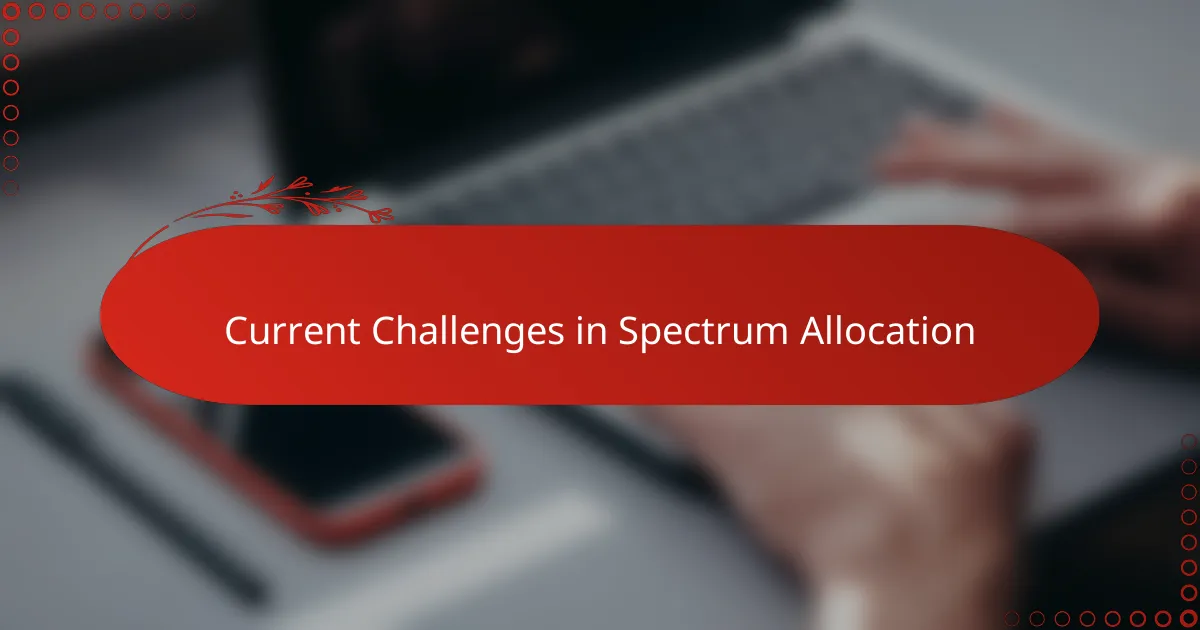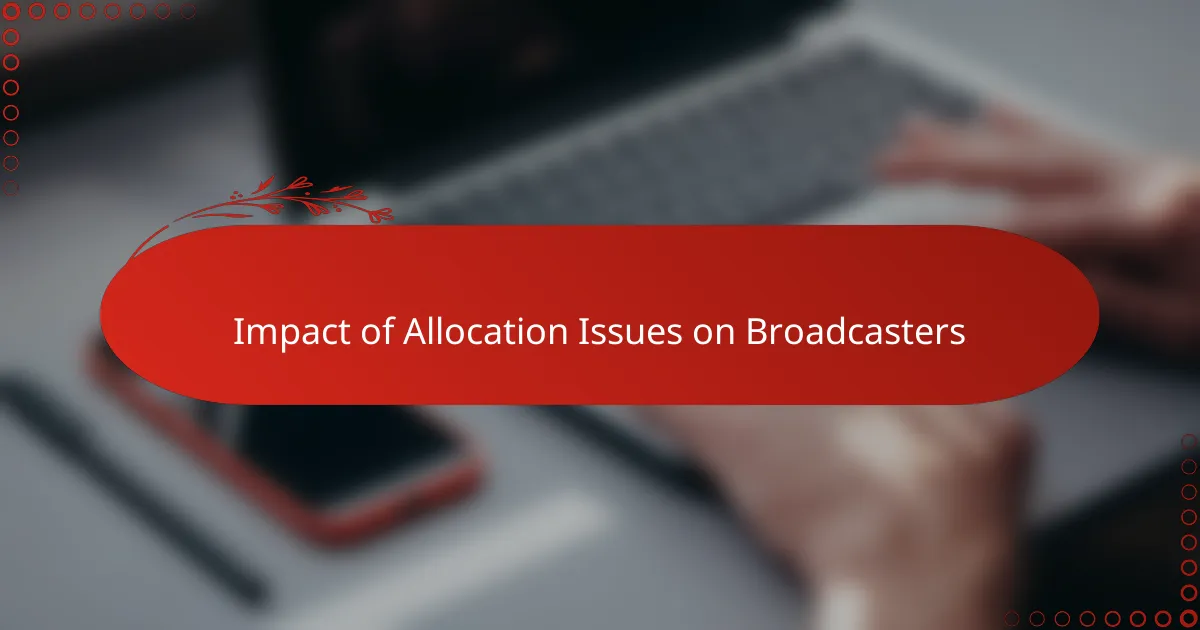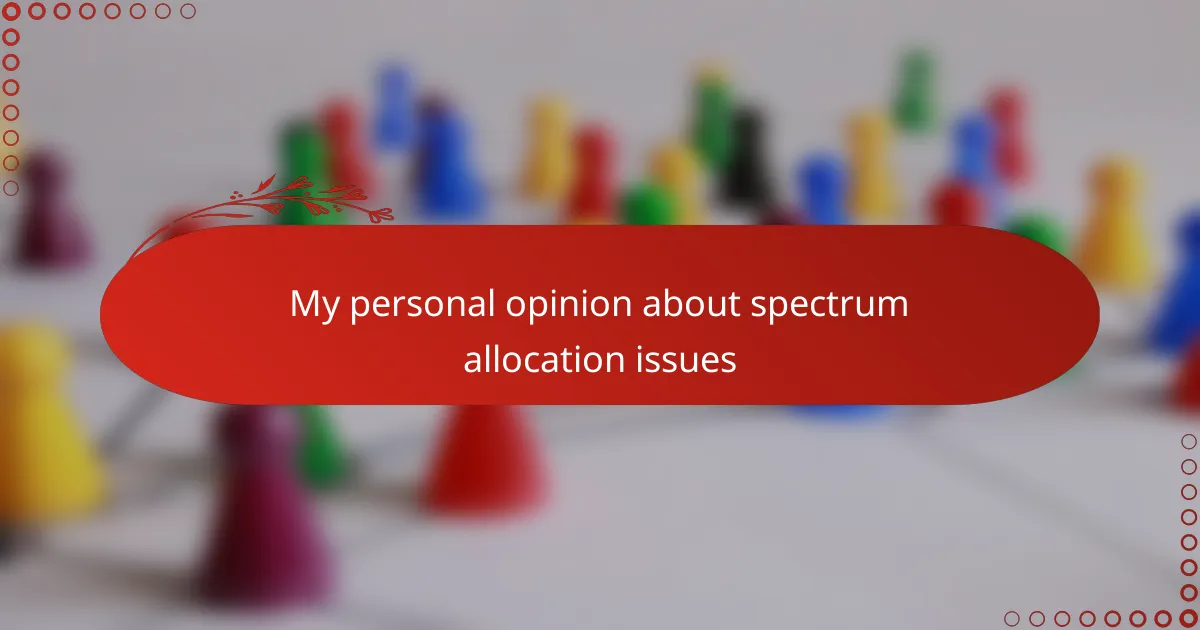Key takeaways
- Spectrum allocation is crucial for ensuring clear radio broadcasting and preventing signal interference among different radio services.
- The increasing demand for spectrum, driven by wireless devices, poses challenges for traditional broadcasters and can lead to reception issues.
- Dynamic allocation and effective collaboration among stakeholders can enhance spectrum management, fostering innovation and reducing interference.
- Future policies should prioritize flexibility and protections for smaller broadcasters to encourage diversity in the radio landscape.

Understanding Spectrum Allocation Basics
Spectrum allocation is essentially the process of dividing and assigning different frequency bands to various radio services. When I first started learning about this, I was surprised by how structured and regulated it all is—almost like a carefully organized neighborhood where everyone has their own space to avoid chaos. Have you ever wondered why your favorite radio station can broadcast clearly without interference? That’s because of these precise allocations.
From my experience in radio broadcasting, understanding these basics is crucial. It’s not just about grabbing any available frequency; it’s about ensuring that the spectrum users coexist without stepping on each other’s toes. I recall a time when poor allocation led to overlapping signals in my area, which made tuning in frustrating—something no listener wants.
Spectrum allocation also involves setting technical standards so equipment and services work harmoniously. This coordination often feels like a delicate balancing act, but it’s vital to keep the airwaves orderly. Without these rules, the radio world would be noisy and confusing, much like a crowded conversation where no one listens.

Importance of Spectrum in Radio Broadcasting
Spectrum is the lifeblood of radio broadcasting. Without access to the right frequency bands, even the most talented broadcasters would be silenced. I remember when a small shift in spectrum availability allowed a new station to launch in my city, and suddenly, the airwaves felt richer and more diverse.
Have you ever tried tuning into a station only to hear static or overlapping voices? That frustration highlights just how critical spectrum management is for a smooth listening experience. From my perspective, the spectrum doesn’t just carry signals; it carries trust between broadcasters and their audience.
In my years working around radio gear, I’ve seen firsthand how limited spectrum can choke innovation and growth. When spectrum is scarce or poorly allocated, broadcasters struggle to expand or improve quality. That’s why I firmly believe protecting and efficiently using spectrum is essential to the future of radio.

Current Challenges in Spectrum Allocation
One challenge that always stands out to me is the increasing demand for spectrum caused by the explosion of wireless devices. It feels like everyone wants a piece of the airwaves, but the available space is limited. Have you noticed how your radio reception sometimes drops during big events or in crowded places? That’s a direct result of this squeeze.
Another complexity is balancing the needs of traditional radio broadcasters with newer technologies that also rely on spectrum. I remember a heated discussion at a conference where many broadcasters felt sidelined as regulators considered reallocating bands for mobile networks. It made me realize how delicate the negotiation process is—one wrong move and entire communities can lose access to the broadcasts they rely on.
Interference and inefficient usage also continue to plague spectrum allocation. I’ve experienced nights when stations surprisingly overlapped, leaving me scrambling to find a clear frequency. It taught me that without stricter enforcement and smarter allocation strategies, listeners and broadcasters alike suffer from poor quality and confusion. This ongoing battle keeps me invested in advocating for better spectrum management.

Impact of Allocation Issues on Broadcasters
Spectrum allocation issues hit broadcasters where it really matters—their ability to reach listeners clearly and consistently. I’ve seen stations forced to reduce power or change frequencies, which not only disrupts their audience but also chips away at their brand identity. Imagine building a loyal following only to have technical limits suddenly silence your voice.
Have you ever noticed a favorite station fading in and out or popping up at strange intervals? That’s often the fallout from poor allocation decisions. It’s frustrating for broadcasters who invest time and resources into programming, only to have interference or crowded bands undermine their efforts. From my experience, it feels like trying to speak in a room full of echoing voices; no message can land properly.
These allocation challenges don’t just affect big players—small, local broadcasters can be hit hardest. I recall a community station I worked with struggling to compete because they were pushed to less desirable frequencies, limiting their reach. It’s a reminder that fair, thoughtful spectrum allocation directly influences the diversity and richness of our broadcast landscape.

Strategies for Effective Spectrum Management
When I think about strategies for managing spectrum effectively, one key approach that comes to mind is dynamic allocation. Instead of rigidly assigning frequencies, allowing flexible use based on demand can prevent idle spectrum and reduce interference. Have you ever noticed how some stations remain silent on certain days? Dynamic use might solve that, making better use of this precious resource.
Coordination among stakeholders is another strategy close to my heart. I’ve seen firsthand how open communication between broadcasters, regulators, and technology providers can smooth conflicts before they escalate. It’s like a neighborhood meeting where everyone agrees on quiet hours and shared spaces—without it, chaos creeps in, and signals get tangled.
Finally, investing in advanced technologies for spectrum sensing and interference mitigation feels essential. I recall nights struggling to tune in during busy events, and I can’t help but wonder: what if smarter tools could automatically adjust settings and clear the airwaves? From where I stand, embracing innovation here isn’t just smart—it’s necessary for keeping radio broadcasting vibrant and reliable.

Personal Insights on Allocation Problems
Spectrum allocation problems often feel like untangling a knot that keeps tightening. I remember encountering a situation where two stations in my region were assigned frequencies too close together, causing constant interference. It made me realize how even small missteps in allocation can ripple into frustrating listening experiences.
Have you ever thought about how political and commercial interests might sway allocation decisions? From what I’ve seen, these pressures can sometimes overshadow the pure technical need, leaving broadcasters caught in the crossfire. It’s a tricky landscape where fairness and influence don’t always align.
At times, I’ve felt that the core issue isn’t just limited spectrum but also how rigid and outdated some allocation frameworks are. Wouldn’t it be great if regulators embraced more adaptive, real-time allocation systems? In my view, that kind of shift could ease many current headaches and open up space for innovation.

Recommendations for Future Spectrum Policies
Looking ahead, I believe spectrum policies must embrace flexibility. Why stick to static allocations when we have technologies that can dynamically sense and adjust frequencies in real time? I’ve seen how rigid assignments sometimes trap valuable airwaves unused, and it feels like a missed opportunity that smarter, adaptive frameworks could fix.
Another recommendation I hold close is prioritizing collaboration among all players—broadcasters, regulators, and tech innovators. When I participated in joint workshops, it struck me how much smoother spectrum sharing became once open dialogue replaced suspicion. Isn’t it time we treated spectrum management more like a community effort than a competitive battle?
Lastly, I think future policies should include stronger protections for smaller broadcasters. I’ve witnessed firsthand how easily local voices get pushed out when spectrum is carved up with only commercial giants in mind. Wouldn’t a fairer, more inclusive allocation encourage diversity and richer radio landscapes that truly serve listeners everywhere? From my experience, this balance is essential for radio to thrive long term.
